Intranet: Development Stages, Misuse, and Remote Access
VerifiedAdded on 2020/05/16
|11
|2510
|208
Report
AI Summary
This report provides a comprehensive overview of Intranets, covering key aspects such as the fifth stage of Intranet development, Pervasion, which ensures that information is accessible across all departments. It defines Computer Supported Collaborative Working Systems (CSCWS) and gives an example of their application. The report discusses the misuse of Intranets, outlining potential dangers and preventive measures, alongside the advantages and disadvantages of remote access to networked services. It also summarizes learning outcomes, emphasizing the significance of user-centric design, pervasive access, and security considerations. This report examines the critical role of Intranets in boosting productivity and improving communication within organizations, highlighting the importance of strategic planning and efficient resource allocation for successful implementation.
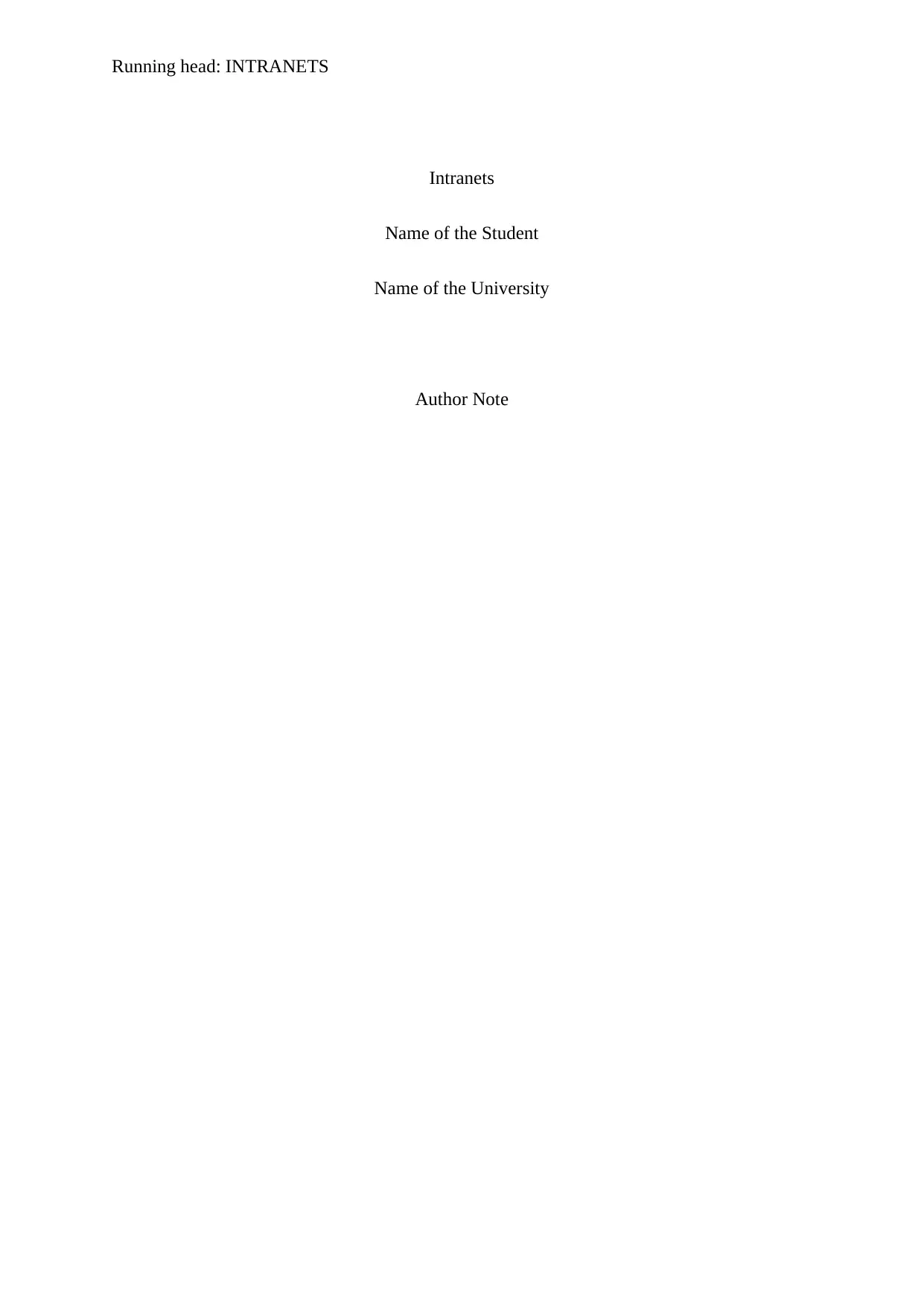
Running head: INTRANETS
Intranets
Name of the Student
Name of the University
Author Note
Intranets
Name of the Student
Name of the University
Author Note
Paraphrase This Document
Need a fresh take? Get an instant paraphrase of this document with our AI Paraphraser
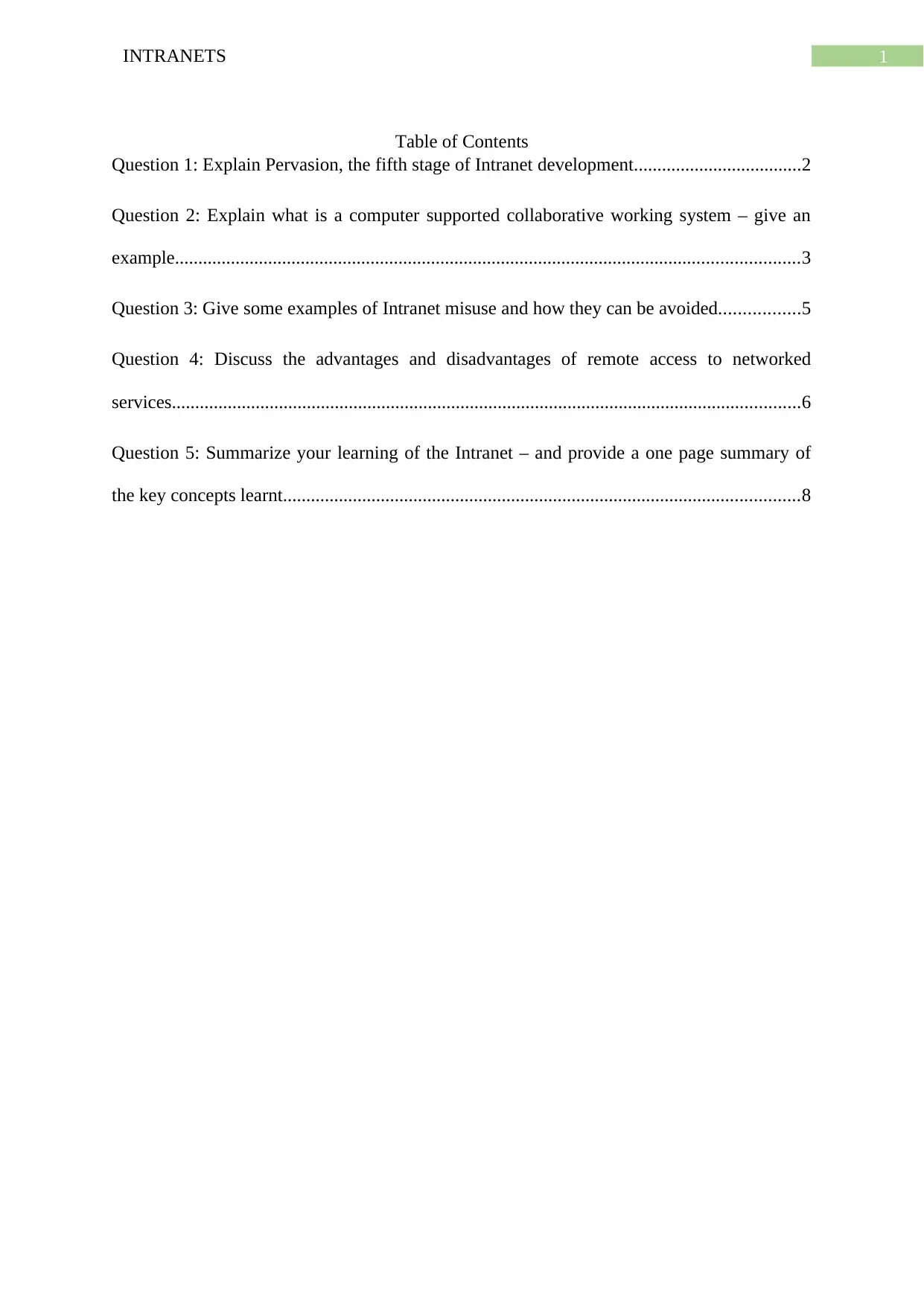
1INTRANETS
Table of Contents
Question 1: Explain Pervasion, the fifth stage of Intranet development....................................2
Question 2: Explain what is a computer supported collaborative working system – give an
example......................................................................................................................................3
Question 3: Give some examples of Intranet misuse and how they can be avoided.................5
Question 4: Discuss the advantages and disadvantages of remote access to networked
services.......................................................................................................................................6
Question 5: Summarize your learning of the Intranet – and provide a one page summary of
the key concepts learnt...............................................................................................................8
Table of Contents
Question 1: Explain Pervasion, the fifth stage of Intranet development....................................2
Question 2: Explain what is a computer supported collaborative working system – give an
example......................................................................................................................................3
Question 3: Give some examples of Intranet misuse and how they can be avoided.................5
Question 4: Discuss the advantages and disadvantages of remote access to networked
services.......................................................................................................................................6
Question 5: Summarize your learning of the Intranet – and provide a one page summary of
the key concepts learnt...............................................................................................................8
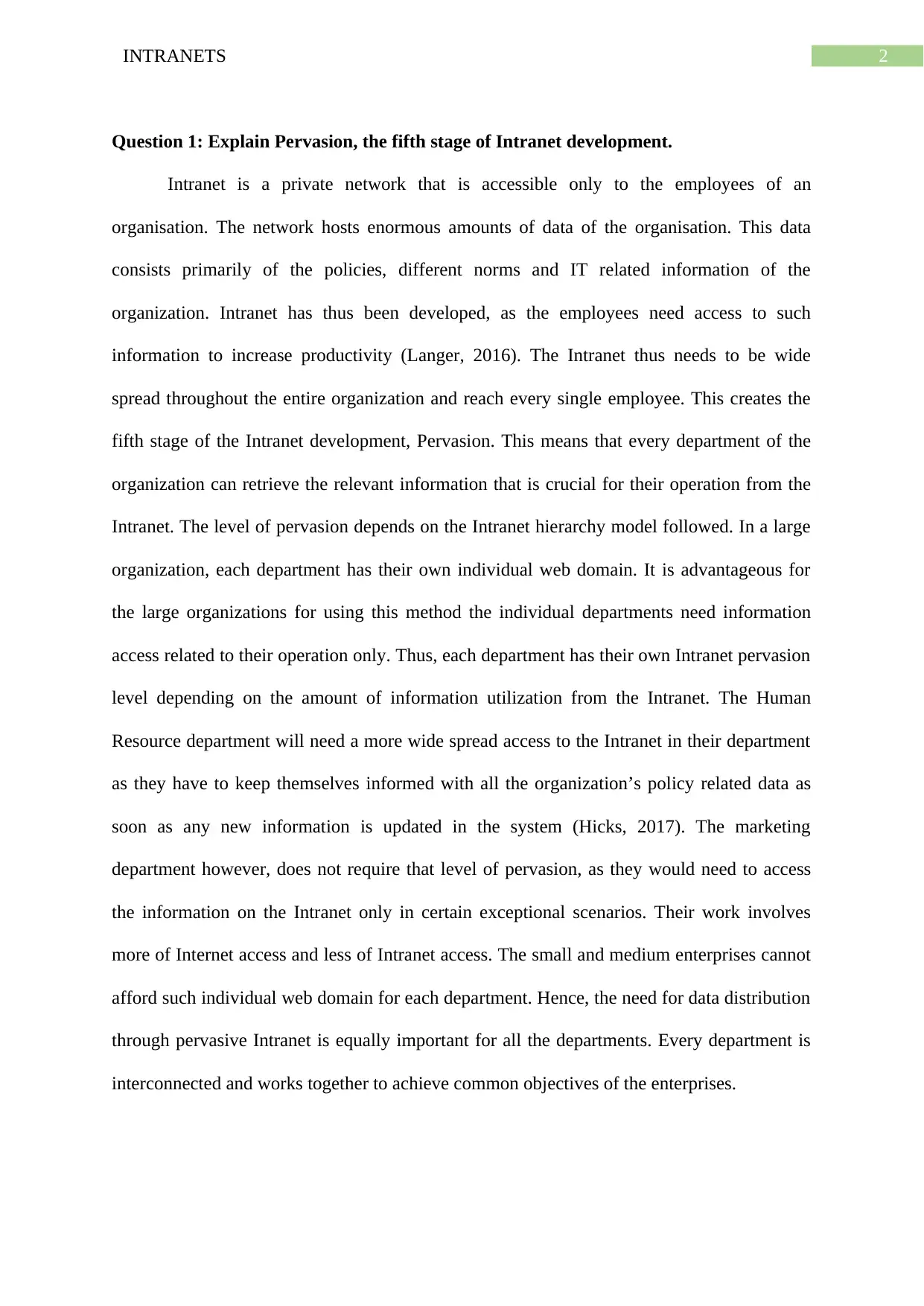
2INTRANETS
Question 1: Explain Pervasion, the fifth stage of Intranet development.
Intranet is a private network that is accessible only to the employees of an
organisation. The network hosts enormous amounts of data of the organisation. This data
consists primarily of the policies, different norms and IT related information of the
organization. Intranet has thus been developed, as the employees need access to such
information to increase productivity (Langer, 2016). The Intranet thus needs to be wide
spread throughout the entire organization and reach every single employee. This creates the
fifth stage of the Intranet development, Pervasion. This means that every department of the
organization can retrieve the relevant information that is crucial for their operation from the
Intranet. The level of pervasion depends on the Intranet hierarchy model followed. In a large
organization, each department has their own individual web domain. It is advantageous for
the large organizations for using this method the individual departments need information
access related to their operation only. Thus, each department has their own Intranet pervasion
level depending on the amount of information utilization from the Intranet. The Human
Resource department will need a more wide spread access to the Intranet in their department
as they have to keep themselves informed with all the organization’s policy related data as
soon as any new information is updated in the system (Hicks, 2017). The marketing
department however, does not require that level of pervasion, as they would need to access
the information on the Intranet only in certain exceptional scenarios. Their work involves
more of Internet access and less of Intranet access. The small and medium enterprises cannot
afford such individual web domain for each department. Hence, the need for data distribution
through pervasive Intranet is equally important for all the departments. Every department is
interconnected and works together to achieve common objectives of the enterprises.
Question 1: Explain Pervasion, the fifth stage of Intranet development.
Intranet is a private network that is accessible only to the employees of an
organisation. The network hosts enormous amounts of data of the organisation. This data
consists primarily of the policies, different norms and IT related information of the
organization. Intranet has thus been developed, as the employees need access to such
information to increase productivity (Langer, 2016). The Intranet thus needs to be wide
spread throughout the entire organization and reach every single employee. This creates the
fifth stage of the Intranet development, Pervasion. This means that every department of the
organization can retrieve the relevant information that is crucial for their operation from the
Intranet. The level of pervasion depends on the Intranet hierarchy model followed. In a large
organization, each department has their own individual web domain. It is advantageous for
the large organizations for using this method the individual departments need information
access related to their operation only. Thus, each department has their own Intranet pervasion
level depending on the amount of information utilization from the Intranet. The Human
Resource department will need a more wide spread access to the Intranet in their department
as they have to keep themselves informed with all the organization’s policy related data as
soon as any new information is updated in the system (Hicks, 2017). The marketing
department however, does not require that level of pervasion, as they would need to access
the information on the Intranet only in certain exceptional scenarios. Their work involves
more of Internet access and less of Intranet access. The small and medium enterprises cannot
afford such individual web domain for each department. Hence, the need for data distribution
through pervasive Intranet is equally important for all the departments. Every department is
interconnected and works together to achieve common objectives of the enterprises.
⊘ This is a preview!⊘
Do you want full access?
Subscribe today to unlock all pages.

Trusted by 1+ million students worldwide
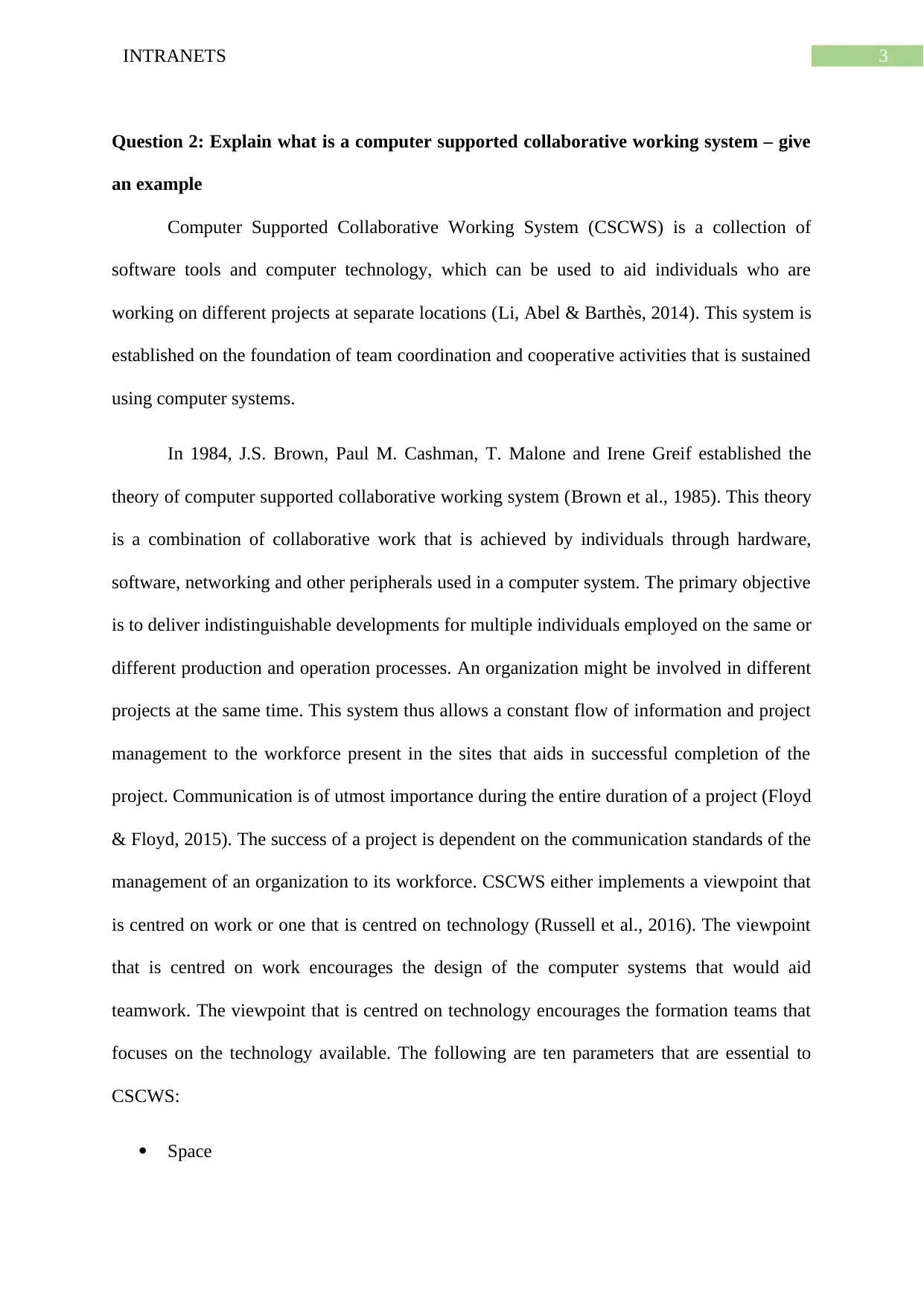
3INTRANETS
Question 2: Explain what is a computer supported collaborative working system – give
an example
Computer Supported Collaborative Working System (CSCWS) is a collection of
software tools and computer technology, which can be used to aid individuals who are
working on different projects at separate locations (Li, Abel & Barthès, 2014). This system is
established on the foundation of team coordination and cooperative activities that is sustained
using computer systems.
In 1984, J.S. Brown, Paul M. Cashman, T. Malone and Irene Greif established the
theory of computer supported collaborative working system (Brown et al., 1985). This theory
is a combination of collaborative work that is achieved by individuals through hardware,
software, networking and other peripherals used in a computer system. The primary objective
is to deliver indistinguishable developments for multiple individuals employed on the same or
different production and operation processes. An organization might be involved in different
projects at the same time. This system thus allows a constant flow of information and project
management to the workforce present in the sites that aids in successful completion of the
project. Communication is of utmost importance during the entire duration of a project (Floyd
& Floyd, 2015). The success of a project is dependent on the communication standards of the
management of an organization to its workforce. CSCWS either implements a viewpoint that
is centred on work or one that is centred on technology (Russell et al., 2016). The viewpoint
that is centred on work encourages the design of the computer systems that would aid
teamwork. The viewpoint that is centred on technology encourages the formation teams that
focuses on the technology available. The following are ten parameters that are essential to
CSCWS:
Space
Question 2: Explain what is a computer supported collaborative working system – give
an example
Computer Supported Collaborative Working System (CSCWS) is a collection of
software tools and computer technology, which can be used to aid individuals who are
working on different projects at separate locations (Li, Abel & Barthès, 2014). This system is
established on the foundation of team coordination and cooperative activities that is sustained
using computer systems.
In 1984, J.S. Brown, Paul M. Cashman, T. Malone and Irene Greif established the
theory of computer supported collaborative working system (Brown et al., 1985). This theory
is a combination of collaborative work that is achieved by individuals through hardware,
software, networking and other peripherals used in a computer system. The primary objective
is to deliver indistinguishable developments for multiple individuals employed on the same or
different production and operation processes. An organization might be involved in different
projects at the same time. This system thus allows a constant flow of information and project
management to the workforce present in the sites that aids in successful completion of the
project. Communication is of utmost importance during the entire duration of a project (Floyd
& Floyd, 2015). The success of a project is dependent on the communication standards of the
management of an organization to its workforce. CSCWS either implements a viewpoint that
is centred on work or one that is centred on technology (Russell et al., 2016). The viewpoint
that is centred on work encourages the design of the computer systems that would aid
teamwork. The viewpoint that is centred on technology encourages the formation teams that
focuses on the technology available. The following are ten parameters that are essential to
CSCWS:
Space
Paraphrase This Document
Need a fresh take? Get an instant paraphrase of this document with our AI Paraphraser
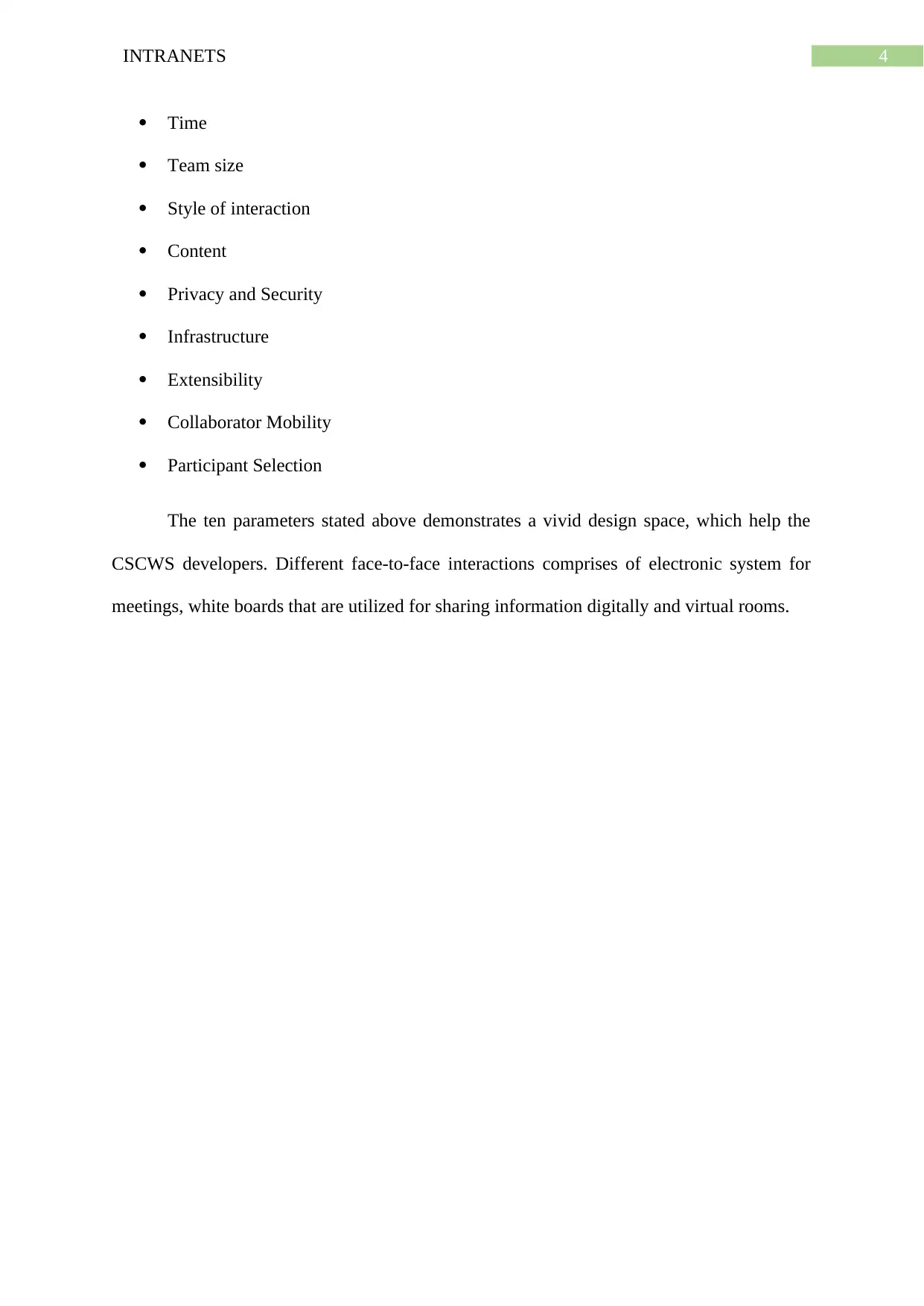
4INTRANETS
Time
Team size
Style of interaction
Content
Privacy and Security
Infrastructure
Extensibility
Collaborator Mobility
Participant Selection
The ten parameters stated above demonstrates a vivid design space, which help the
CSCWS developers. Different face-to-face interactions comprises of electronic system for
meetings, white boards that are utilized for sharing information digitally and virtual rooms.
Time
Team size
Style of interaction
Content
Privacy and Security
Infrastructure
Extensibility
Collaborator Mobility
Participant Selection
The ten parameters stated above demonstrates a vivid design space, which help the
CSCWS developers. Different face-to-face interactions comprises of electronic system for
meetings, white boards that are utilized for sharing information digitally and virtual rooms.
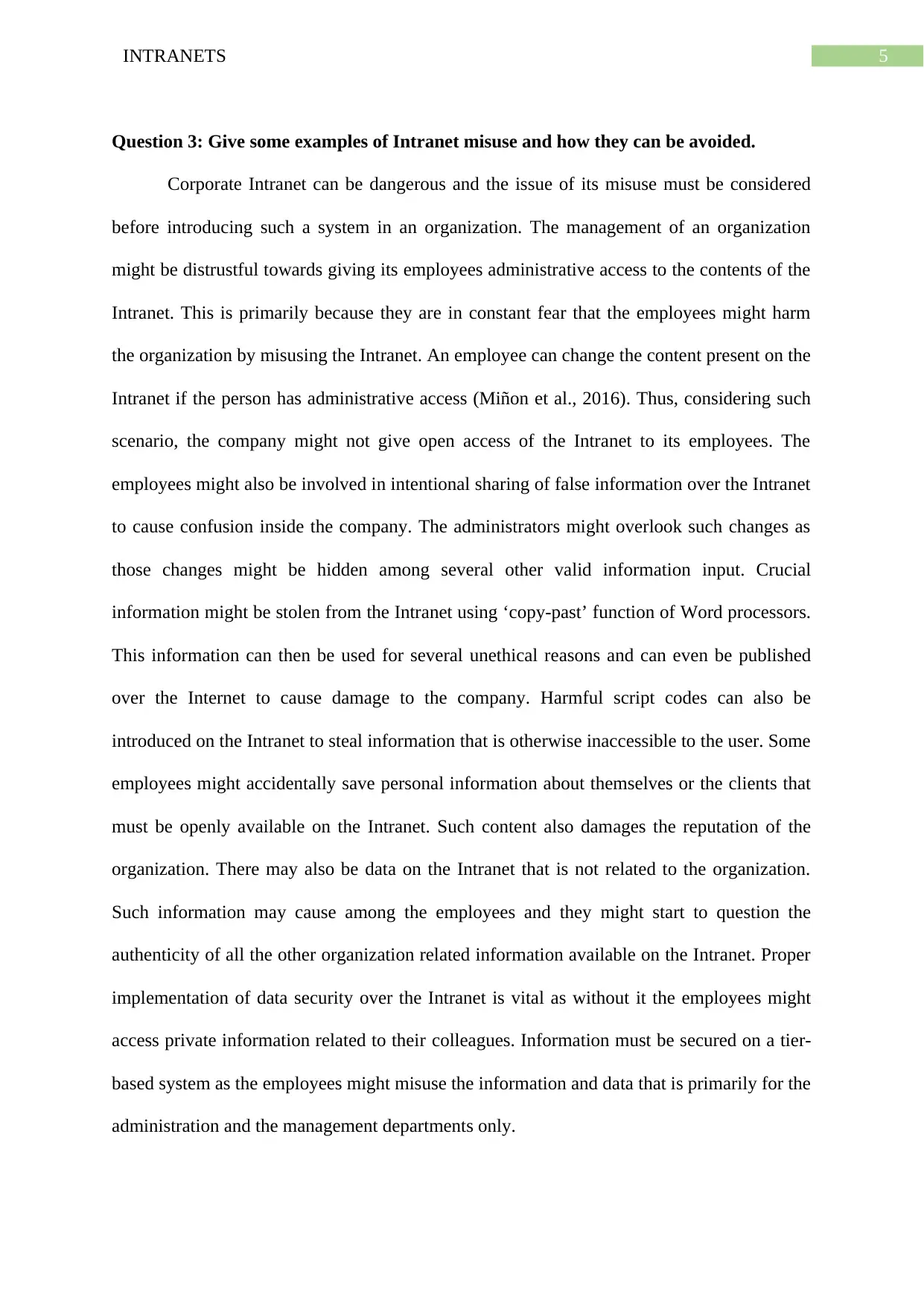
5INTRANETS
Question 3: Give some examples of Intranet misuse and how they can be avoided.
Corporate Intranet can be dangerous and the issue of its misuse must be considered
before introducing such a system in an organization. The management of an organization
might be distrustful towards giving its employees administrative access to the contents of the
Intranet. This is primarily because they are in constant fear that the employees might harm
the organization by misusing the Intranet. An employee can change the content present on the
Intranet if the person has administrative access (Miñon et al., 2016). Thus, considering such
scenario, the company might not give open access of the Intranet to its employees. The
employees might also be involved in intentional sharing of false information over the Intranet
to cause confusion inside the company. The administrators might overlook such changes as
those changes might be hidden among several other valid information input. Crucial
information might be stolen from the Intranet using ‘copy-past’ function of Word processors.
This information can then be used for several unethical reasons and can even be published
over the Internet to cause damage to the company. Harmful script codes can also be
introduced on the Intranet to steal information that is otherwise inaccessible to the user. Some
employees might accidentally save personal information about themselves or the clients that
must be openly available on the Intranet. Such content also damages the reputation of the
organization. There may also be data on the Intranet that is not related to the organization.
Such information may cause among the employees and they might start to question the
authenticity of all the other organization related information available on the Intranet. Proper
implementation of data security over the Intranet is vital as without it the employees might
access private information related to their colleagues. Information must be secured on a tier-
based system as the employees might misuse the information and data that is primarily for the
administration and the management departments only.
Question 3: Give some examples of Intranet misuse and how they can be avoided.
Corporate Intranet can be dangerous and the issue of its misuse must be considered
before introducing such a system in an organization. The management of an organization
might be distrustful towards giving its employees administrative access to the contents of the
Intranet. This is primarily because they are in constant fear that the employees might harm
the organization by misusing the Intranet. An employee can change the content present on the
Intranet if the person has administrative access (Miñon et al., 2016). Thus, considering such
scenario, the company might not give open access of the Intranet to its employees. The
employees might also be involved in intentional sharing of false information over the Intranet
to cause confusion inside the company. The administrators might overlook such changes as
those changes might be hidden among several other valid information input. Crucial
information might be stolen from the Intranet using ‘copy-past’ function of Word processors.
This information can then be used for several unethical reasons and can even be published
over the Internet to cause damage to the company. Harmful script codes can also be
introduced on the Intranet to steal information that is otherwise inaccessible to the user. Some
employees might accidentally save personal information about themselves or the clients that
must be openly available on the Intranet. Such content also damages the reputation of the
organization. There may also be data on the Intranet that is not related to the organization.
Such information may cause among the employees and they might start to question the
authenticity of all the other organization related information available on the Intranet. Proper
implementation of data security over the Intranet is vital as without it the employees might
access private information related to their colleagues. Information must be secured on a tier-
based system as the employees might misuse the information and data that is primarily for the
administration and the management departments only.
⊘ This is a preview!⊘
Do you want full access?
Subscribe today to unlock all pages.

Trusted by 1+ million students worldwide
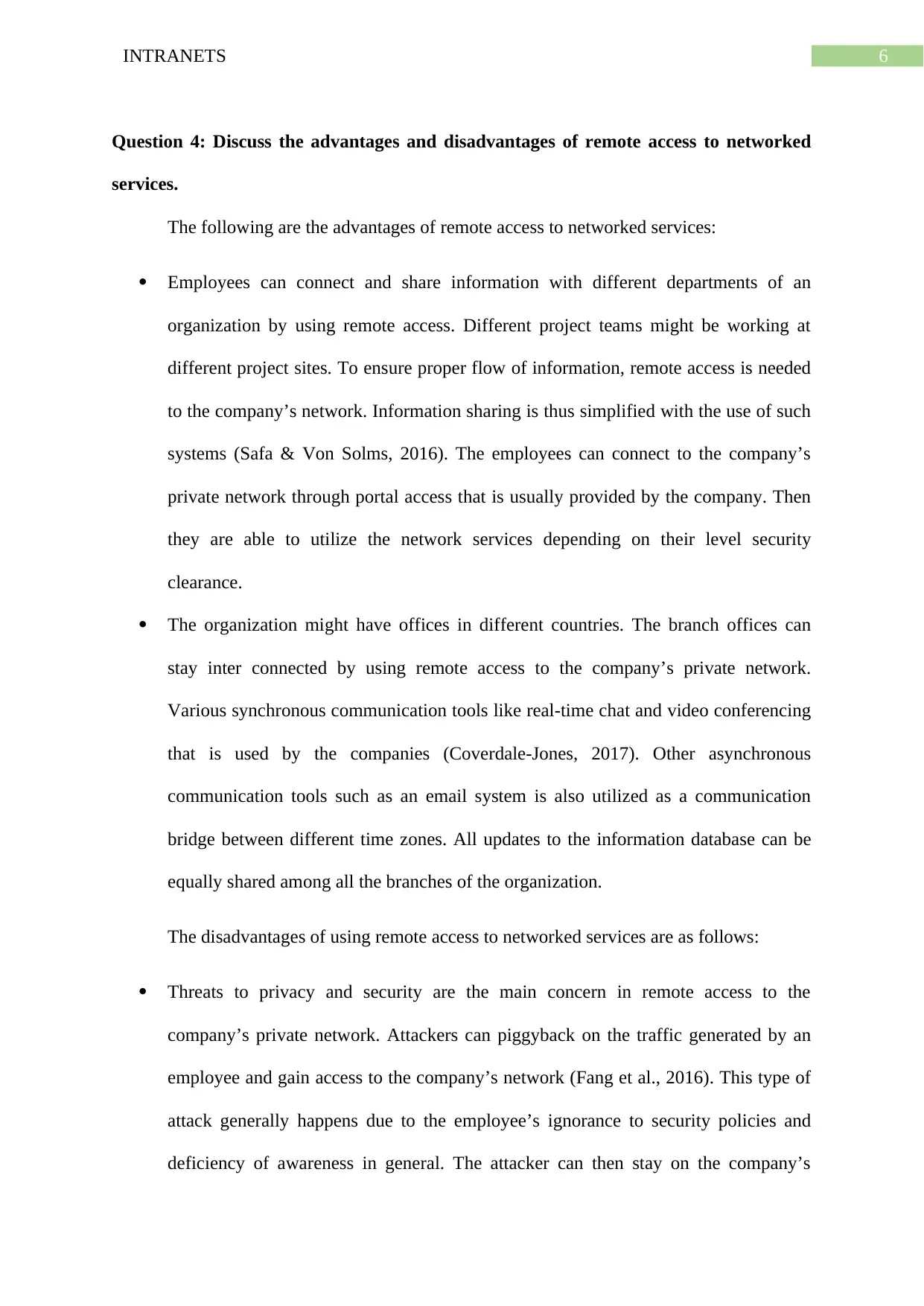
6INTRANETS
Question 4: Discuss the advantages and disadvantages of remote access to networked
services.
The following are the advantages of remote access to networked services:
Employees can connect and share information with different departments of an
organization by using remote access. Different project teams might be working at
different project sites. To ensure proper flow of information, remote access is needed
to the company’s network. Information sharing is thus simplified with the use of such
systems (Safa & Von Solms, 2016). The employees can connect to the company’s
private network through portal access that is usually provided by the company. Then
they are able to utilize the network services depending on their level security
clearance.
The organization might have offices in different countries. The branch offices can
stay inter connected by using remote access to the company’s private network.
Various synchronous communication tools like real-time chat and video conferencing
that is used by the companies (Coverdale-Jones, 2017). Other asynchronous
communication tools such as an email system is also utilized as a communication
bridge between different time zones. All updates to the information database can be
equally shared among all the branches of the organization.
The disadvantages of using remote access to networked services are as follows:
Threats to privacy and security are the main concern in remote access to the
company’s private network. Attackers can piggyback on the traffic generated by an
employee and gain access to the company’s network (Fang et al., 2016). This type of
attack generally happens due to the employee’s ignorance to security policies and
deficiency of awareness in general. The attacker can then stay on the company’s
Question 4: Discuss the advantages and disadvantages of remote access to networked
services.
The following are the advantages of remote access to networked services:
Employees can connect and share information with different departments of an
organization by using remote access. Different project teams might be working at
different project sites. To ensure proper flow of information, remote access is needed
to the company’s network. Information sharing is thus simplified with the use of such
systems (Safa & Von Solms, 2016). The employees can connect to the company’s
private network through portal access that is usually provided by the company. Then
they are able to utilize the network services depending on their level security
clearance.
The organization might have offices in different countries. The branch offices can
stay inter connected by using remote access to the company’s private network.
Various synchronous communication tools like real-time chat and video conferencing
that is used by the companies (Coverdale-Jones, 2017). Other asynchronous
communication tools such as an email system is also utilized as a communication
bridge between different time zones. All updates to the information database can be
equally shared among all the branches of the organization.
The disadvantages of using remote access to networked services are as follows:
Threats to privacy and security are the main concern in remote access to the
company’s private network. Attackers can piggyback on the traffic generated by an
employee and gain access to the company’s network (Fang et al., 2016). This type of
attack generally happens due to the employee’s ignorance to security policies and
deficiency of awareness in general. The attacker can then stay on the company’s
Paraphrase This Document
Need a fresh take? Get an instant paraphrase of this document with our AI Paraphraser
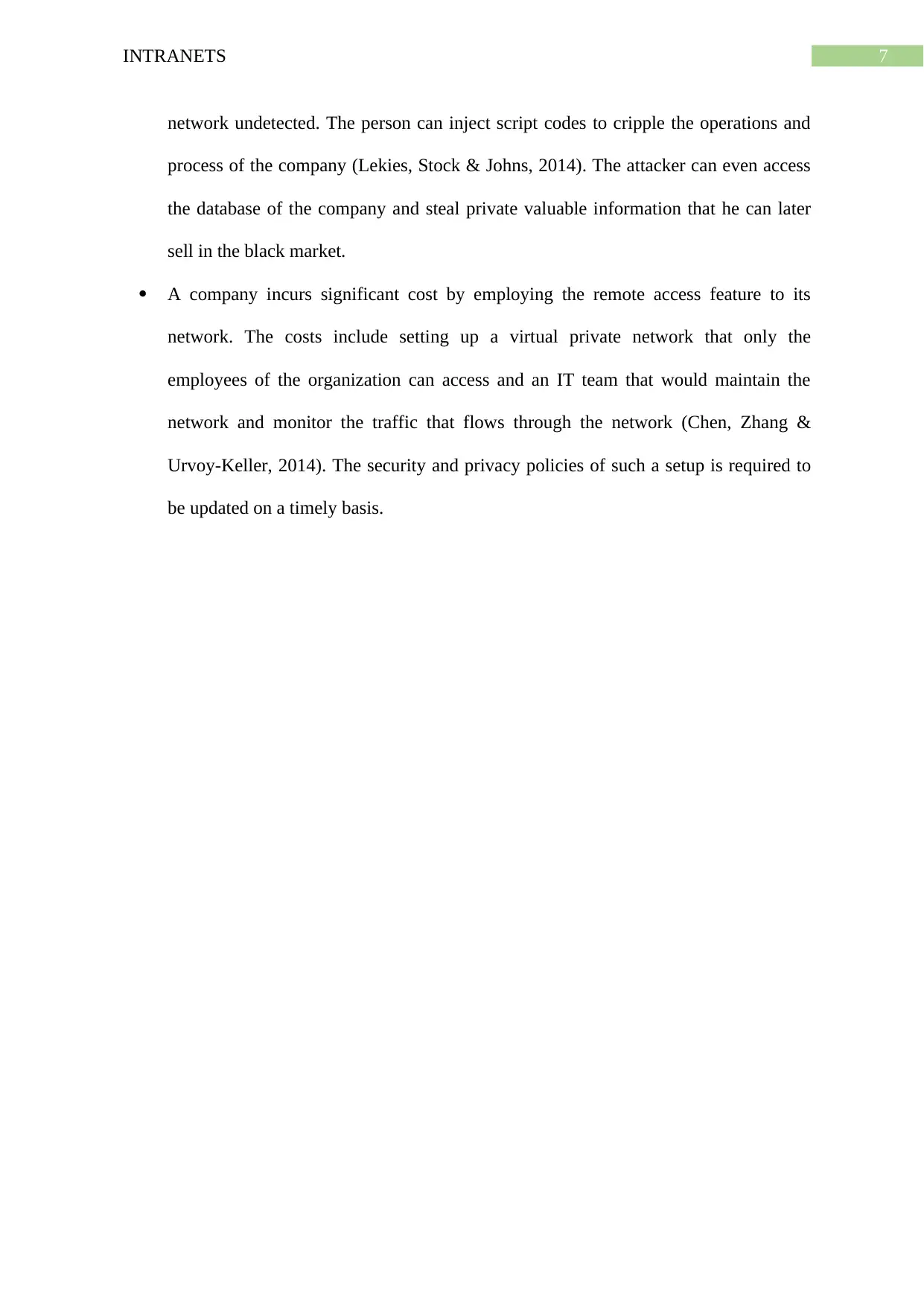
7INTRANETS
network undetected. The person can inject script codes to cripple the operations and
process of the company (Lekies, Stock & Johns, 2014). The attacker can even access
the database of the company and steal private valuable information that he can later
sell in the black market.
A company incurs significant cost by employing the remote access feature to its
network. The costs include setting up a virtual private network that only the
employees of the organization can access and an IT team that would maintain the
network and monitor the traffic that flows through the network (Chen, Zhang &
Urvoy-Keller, 2014). The security and privacy policies of such a setup is required to
be updated on a timely basis.
network undetected. The person can inject script codes to cripple the operations and
process of the company (Lekies, Stock & Johns, 2014). The attacker can even access
the database of the company and steal private valuable information that he can later
sell in the black market.
A company incurs significant cost by employing the remote access feature to its
network. The costs include setting up a virtual private network that only the
employees of the organization can access and an IT team that would maintain the
network and monitor the traffic that flows through the network (Chen, Zhang &
Urvoy-Keller, 2014). The security and privacy policies of such a setup is required to
be updated on a timely basis.
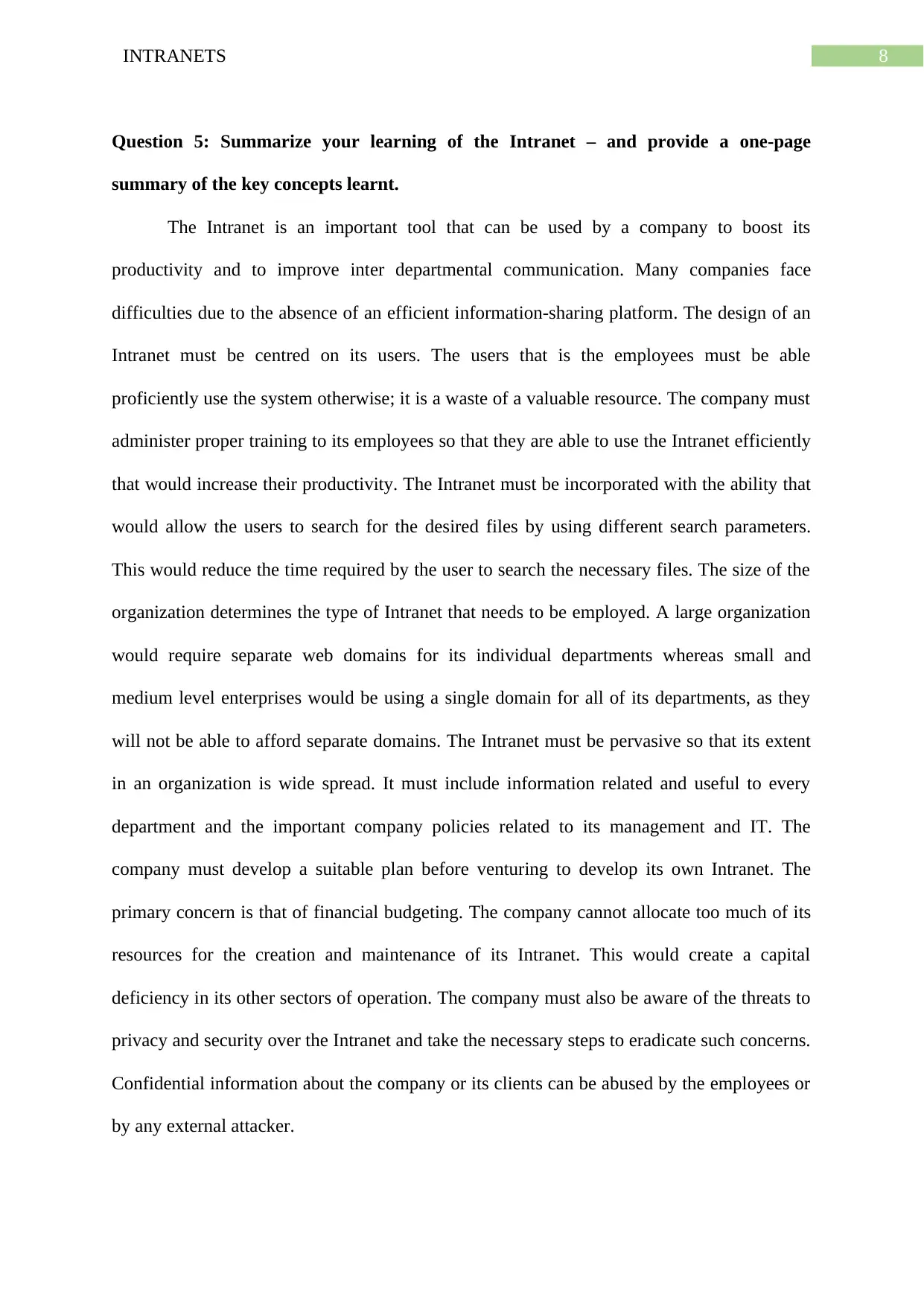
8INTRANETS
Question 5: Summarize your learning of the Intranet – and provide a one-page
summary of the key concepts learnt.
The Intranet is an important tool that can be used by a company to boost its
productivity and to improve inter departmental communication. Many companies face
difficulties due to the absence of an efficient information-sharing platform. The design of an
Intranet must be centred on its users. The users that is the employees must be able
proficiently use the system otherwise; it is a waste of a valuable resource. The company must
administer proper training to its employees so that they are able to use the Intranet efficiently
that would increase their productivity. The Intranet must be incorporated with the ability that
would allow the users to search for the desired files by using different search parameters.
This would reduce the time required by the user to search the necessary files. The size of the
organization determines the type of Intranet that needs to be employed. A large organization
would require separate web domains for its individual departments whereas small and
medium level enterprises would be using a single domain for all of its departments, as they
will not be able to afford separate domains. The Intranet must be pervasive so that its extent
in an organization is wide spread. It must include information related and useful to every
department and the important company policies related to its management and IT. The
company must develop a suitable plan before venturing to develop its own Intranet. The
primary concern is that of financial budgeting. The company cannot allocate too much of its
resources for the creation and maintenance of its Intranet. This would create a capital
deficiency in its other sectors of operation. The company must also be aware of the threats to
privacy and security over the Intranet and take the necessary steps to eradicate such concerns.
Confidential information about the company or its clients can be abused by the employees or
by any external attacker.
Question 5: Summarize your learning of the Intranet – and provide a one-page
summary of the key concepts learnt.
The Intranet is an important tool that can be used by a company to boost its
productivity and to improve inter departmental communication. Many companies face
difficulties due to the absence of an efficient information-sharing platform. The design of an
Intranet must be centred on its users. The users that is the employees must be able
proficiently use the system otherwise; it is a waste of a valuable resource. The company must
administer proper training to its employees so that they are able to use the Intranet efficiently
that would increase their productivity. The Intranet must be incorporated with the ability that
would allow the users to search for the desired files by using different search parameters.
This would reduce the time required by the user to search the necessary files. The size of the
organization determines the type of Intranet that needs to be employed. A large organization
would require separate web domains for its individual departments whereas small and
medium level enterprises would be using a single domain for all of its departments, as they
will not be able to afford separate domains. The Intranet must be pervasive so that its extent
in an organization is wide spread. It must include information related and useful to every
department and the important company policies related to its management and IT. The
company must develop a suitable plan before venturing to develop its own Intranet. The
primary concern is that of financial budgeting. The company cannot allocate too much of its
resources for the creation and maintenance of its Intranet. This would create a capital
deficiency in its other sectors of operation. The company must also be aware of the threats to
privacy and security over the Intranet and take the necessary steps to eradicate such concerns.
Confidential information about the company or its clients can be abused by the employees or
by any external attacker.
⊘ This is a preview!⊘
Do you want full access?
Subscribe today to unlock all pages.

Trusted by 1+ million students worldwide
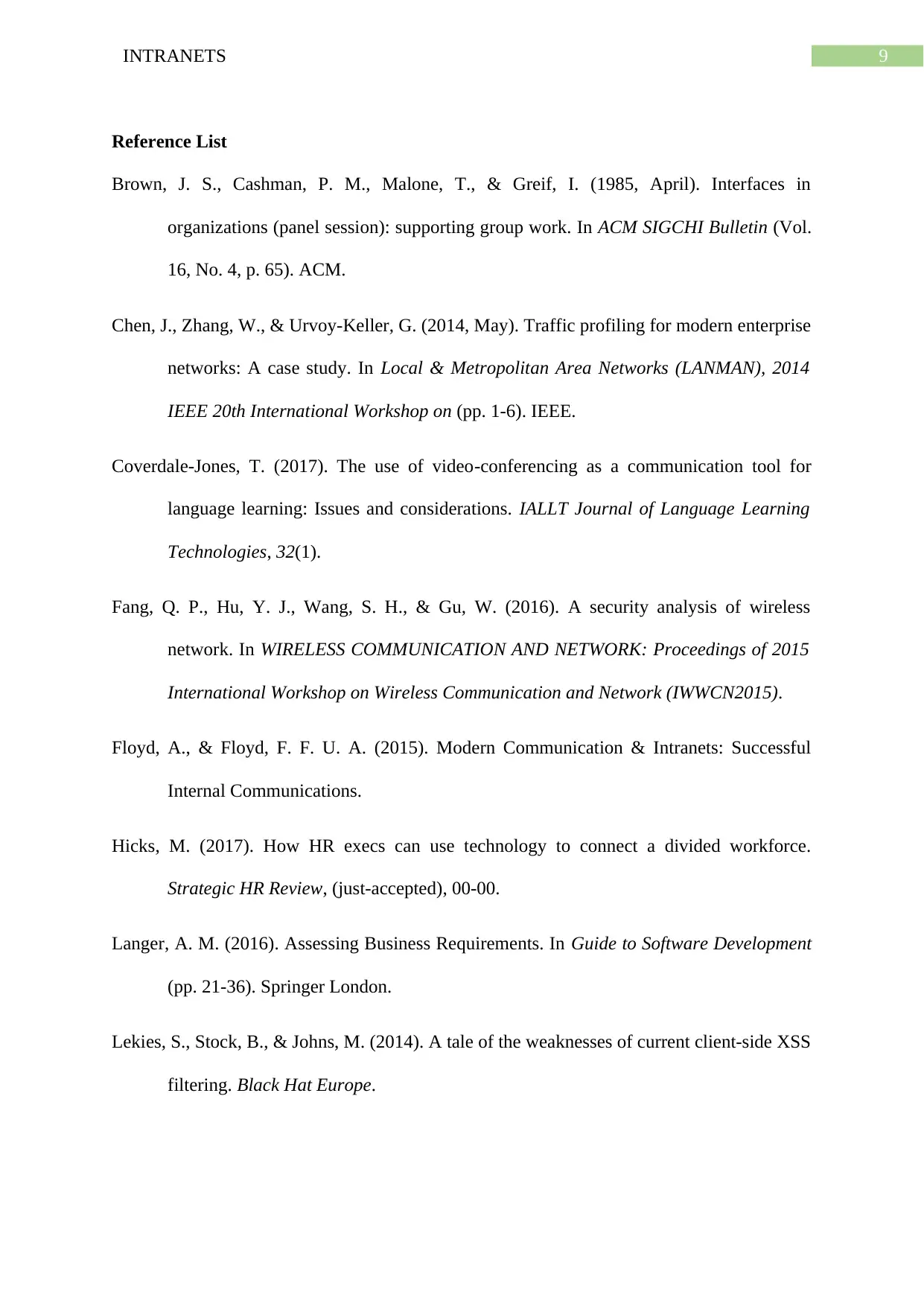
9INTRANETS
Reference List
Brown, J. S., Cashman, P. M., Malone, T., & Greif, I. (1985, April). Interfaces in
organizations (panel session): supporting group work. In ACM SIGCHI Bulletin (Vol.
16, No. 4, p. 65). ACM.
Chen, J., Zhang, W., & Urvoy-Keller, G. (2014, May). Traffic profiling for modern enterprise
networks: A case study. In Local & Metropolitan Area Networks (LANMAN), 2014
IEEE 20th International Workshop on (pp. 1-6). IEEE.
Coverdale-Jones, T. (2017). The use of video-conferencing as a communication tool for
language learning: Issues and considerations. IALLT Journal of Language Learning
Technologies, 32(1).
Fang, Q. P., Hu, Y. J., Wang, S. H., & Gu, W. (2016). A security analysis of wireless
network. In WIRELESS COMMUNICATION AND NETWORK: Proceedings of 2015
International Workshop on Wireless Communication and Network (IWWCN2015).
Floyd, A., & Floyd, F. F. U. A. (2015). Modern Communication & Intranets: Successful
Internal Communications.
Hicks, M. (2017). How HR execs can use technology to connect a divided workforce.
Strategic HR Review, (just-accepted), 00-00.
Langer, A. M. (2016). Assessing Business Requirements. In Guide to Software Development
(pp. 21-36). Springer London.
Lekies, S., Stock, B., & Johns, M. (2014). A tale of the weaknesses of current client-side XSS
filtering. Black Hat Europe.
Reference List
Brown, J. S., Cashman, P. M., Malone, T., & Greif, I. (1985, April). Interfaces in
organizations (panel session): supporting group work. In ACM SIGCHI Bulletin (Vol.
16, No. 4, p. 65). ACM.
Chen, J., Zhang, W., & Urvoy-Keller, G. (2014, May). Traffic profiling for modern enterprise
networks: A case study. In Local & Metropolitan Area Networks (LANMAN), 2014
IEEE 20th International Workshop on (pp. 1-6). IEEE.
Coverdale-Jones, T. (2017). The use of video-conferencing as a communication tool for
language learning: Issues and considerations. IALLT Journal of Language Learning
Technologies, 32(1).
Fang, Q. P., Hu, Y. J., Wang, S. H., & Gu, W. (2016). A security analysis of wireless
network. In WIRELESS COMMUNICATION AND NETWORK: Proceedings of 2015
International Workshop on Wireless Communication and Network (IWWCN2015).
Floyd, A., & Floyd, F. F. U. A. (2015). Modern Communication & Intranets: Successful
Internal Communications.
Hicks, M. (2017). How HR execs can use technology to connect a divided workforce.
Strategic HR Review, (just-accepted), 00-00.
Langer, A. M. (2016). Assessing Business Requirements. In Guide to Software Development
(pp. 21-36). Springer London.
Lekies, S., Stock, B., & Johns, M. (2014). A tale of the weaknesses of current client-side XSS
filtering. Black Hat Europe.
Paraphrase This Document
Need a fresh take? Get an instant paraphrase of this document with our AI Paraphraser
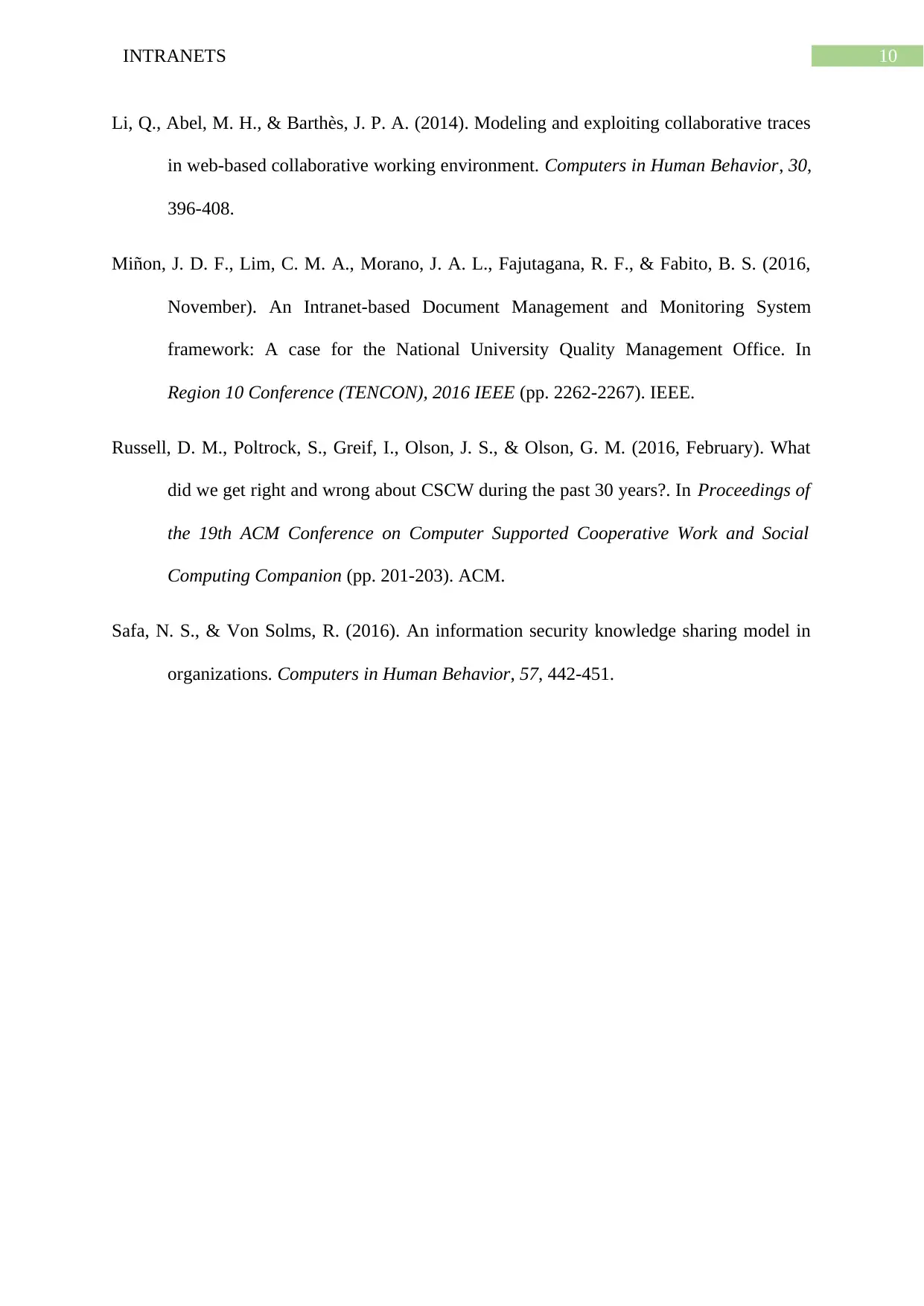
10INTRANETS
Li, Q., Abel, M. H., & Barthès, J. P. A. (2014). Modeling and exploiting collaborative traces
in web-based collaborative working environment. Computers in Human Behavior, 30,
396-408.
Miñon, J. D. F., Lim, C. M. A., Morano, J. A. L., Fajutagana, R. F., & Fabito, B. S. (2016,
November). An Intranet-based Document Management and Monitoring System
framework: A case for the National University Quality Management Office. In
Region 10 Conference (TENCON), 2016 IEEE (pp. 2262-2267). IEEE.
Russell, D. M., Poltrock, S., Greif, I., Olson, J. S., & Olson, G. M. (2016, February). What
did we get right and wrong about CSCW during the past 30 years?. In Proceedings of
the 19th ACM Conference on Computer Supported Cooperative Work and Social
Computing Companion (pp. 201-203). ACM.
Safa, N. S., & Von Solms, R. (2016). An information security knowledge sharing model in
organizations. Computers in Human Behavior, 57, 442-451.
Li, Q., Abel, M. H., & Barthès, J. P. A. (2014). Modeling and exploiting collaborative traces
in web-based collaborative working environment. Computers in Human Behavior, 30,
396-408.
Miñon, J. D. F., Lim, C. M. A., Morano, J. A. L., Fajutagana, R. F., & Fabito, B. S. (2016,
November). An Intranet-based Document Management and Monitoring System
framework: A case for the National University Quality Management Office. In
Region 10 Conference (TENCON), 2016 IEEE (pp. 2262-2267). IEEE.
Russell, D. M., Poltrock, S., Greif, I., Olson, J. S., & Olson, G. M. (2016, February). What
did we get right and wrong about CSCW during the past 30 years?. In Proceedings of
the 19th ACM Conference on Computer Supported Cooperative Work and Social
Computing Companion (pp. 201-203). ACM.
Safa, N. S., & Von Solms, R. (2016). An information security knowledge sharing model in
organizations. Computers in Human Behavior, 57, 442-451.
1 out of 11
Related Documents
Your All-in-One AI-Powered Toolkit for Academic Success.
+13062052269
info@desklib.com
Available 24*7 on WhatsApp / Email
![[object Object]](/_next/static/media/star-bottom.7253800d.svg)
Unlock your academic potential
Copyright © 2020–2025 A2Z Services. All Rights Reserved. Developed and managed by ZUCOL.





